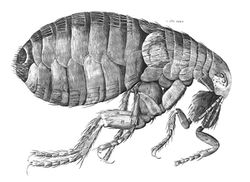Difference between revisions of "Flea Structure"
| (7 intermediate revisions by 3 users not shown) | |||
| Line 1: | Line 1: | ||
| − | [[Image: flea.jpg|thumb|right|250px| | + | {{unfinished}} |
| − | [[Image:Flea Diagram.jpg|thumb|right|150px| | + | [[Image: flea.jpg|thumb|right|250px|Robert Hooke's famous flea from Micrographia]] |
| − | + | [[Image:Flea Diagram.jpg|thumb|right|150px|Flea Diagram - Wikimedia Commons]] | |
| − | Fleas make up the taxonomical order ''Siphonaptera'' containing approximately 2500 species all of which are very similar in morphology. All are obligate blood feeders, which is apparent in the morphology of the mouthparts. Though they are all small, between 1 and 6mm, there is considerable sexual dimporphism, the females being larger than the males. The body of the flea is laterally flattened | + | =Overview= |
| − | + | Fleas make up the taxonomical order ''Siphonaptera'' containing approximately 2500 species all of which are very similar in morphology. All are obligate blood feeders, which is apparent in the morphology of the mouthparts. Though they are all small, between 1 and 6mm, there is considerable sexual dimporphism, the females being larger than the males. The body of the flea is laterally flattened | |
| − | + | The terms '''ctenidia''' and '''combs''' can be used interchangably for spines on the head/thorax. Spines on the cheeks are referred to as '''genal''' and spines on the thorax are called '''pronotal''' combs. The presence and location of the chitinous spines are important in differentiating between the different flea species. The chitinous anal struts are also used for identification and help the flea larvae with vigorous motility. | |
| − | The | + | [[Category:Fleas]] |
| − | |||
| − | |||
| − | |||
| − | |||
| − | |||
| − | |||
| − | |||
| − | |||
| − | |||
| − | |||
| − | |||
| − | |||
| − | [[Category:Fleas | ||
[[Category:To_Do_-_Parasites]] | [[Category:To_Do_-_Parasites]] | ||
| + | [[Category:To_Do_-_NickJ]] | ||
Revision as of 22:30, 19 July 2010
| This article is still under construction. |
Overview
Fleas make up the taxonomical order Siphonaptera containing approximately 2500 species all of which are very similar in morphology. All are obligate blood feeders, which is apparent in the morphology of the mouthparts. Though they are all small, between 1 and 6mm, there is considerable sexual dimporphism, the females being larger than the males. The body of the flea is laterally flattened The terms ctenidia and combs can be used interchangably for spines on the head/thorax. Spines on the cheeks are referred to as genal and spines on the thorax are called pronotal combs. The presence and location of the chitinous spines are important in differentiating between the different flea species. The chitinous anal struts are also used for identification and help the flea larvae with vigorous motility.

